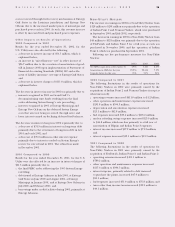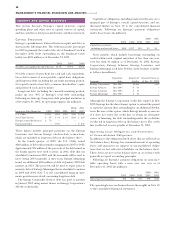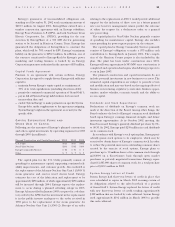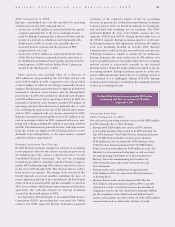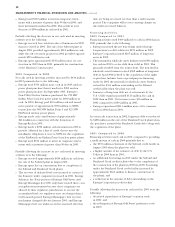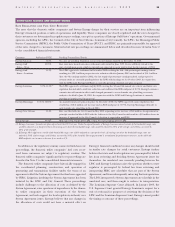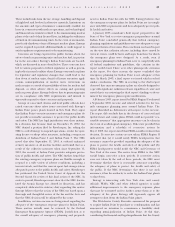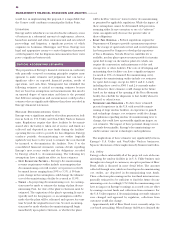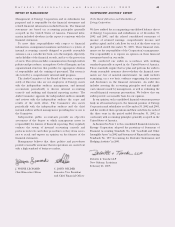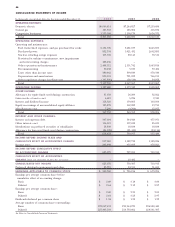Entergy 2002 Annual Report Download - page 37
Download and view the complete annual report
Please find page 37 of the 2002 Entergy annual report below. You can navigate through the pages in the report by either clicking on the pages listed below, or by using the keyword search tool below to find specific information within the annual report.
EKT seeks to limit the daily value-at-risk on any given day to
a certain dollar amount approved by the trading committee.
EKT’s value-at-risk measures, which it calls Daily Earnings
at Risk (DE@R), for its trading portfolio were as follows
(in millions):
2002 2001
DE@R at end of period $15.2 $5.5
Average DE@R for the period $10.8 $6.4
EKT’s DE@R increased in 2002 compared to 2001 as a result of
an increase in the size of the position held and an increase in
the volatility of natural gas prices in the latter part of the year.
For all derivative and contractual transactions, EKT is
exposed to losses in the event of nonperformance by counter-
parties to these transactions. Relevant considerations when
assessing EKT’s credit risk exposure include:
EKT’s operations are primarily concentrated in the
energy industry.
EKT’s trade receivables and other financial instruments
are predominantly with energy, utility, and financial
services related companies, as well as other trading
companies in the U.S., United Kingdom (UK), and
Western Europe.
EKT maintains credit policies, which its management
believes minimize overall credit risk.
Prospective and existing customers are reviewed for credit-
worthiness based upon pre-established standards, with
customers not meeting minimum standards providing
various secured payment terms, including the posting
of cash collateral.
EKT also has master netting agreements in place. These
agreements allow EKT to offset cash and non-cash gains
and losses arising from derivative instruments with the
same counterparty. EKT’s policy is to have such master
netting agreements in place with significant counterparties.
Based on EKT’s policies, risk exposures, and valuation adjust-
ments related to credit, EKT does not anticipate a material
adverse effect on its financial position as a result of counterparty
nonperformance. As of December 31, 2002 approximately 86%
of EKT’s counterparty credit exposure is associated with compa-
nies that have at least investment grade credit ratings.
Following are EKT’s mark-to-market assets (liabilities) and
the period within which the assets (liabilities) would be
realized (paid) in cash if they are held to maturity and market
prices are unchanged (in millions):
Maturities and Sources for Fair
Value of Trading Contracts at
December 31, 2002 2003 2004 2005-2006 Total
Prices actively quoted $45.0 $45.1 $(20.2) $69.9
Prices provided by
other sources 24.4 3.3 1.9 29.6
Prices based on models (13.3) 1.3 3.4 (8.6)
Total $56.1 $49.7 $(14.9) $90.9
Following is a roll-forward of the change in the fair value of
EKT’s mark-to-market contracts during 2002 (in millions):
2002
Fair value of contracts at December 31, 2001 $106
Fair value of contracts settled during the year (347)
Initial recorded value of new contracts
entered into during the year 7
Net option premiums received during the year (78)
Change in fair value of contracts attributable to
market movements during the year 403
Net change in contracts outstanding during the year (15)
Fair value of contracts at December 31, 2002 $ 91
Foreign Currency Exchange Rate Risk
Entergy Gulf States, System Fuels, and Entergy’s Non-Utility
Nuclear business entered into foreign currency forward
contracts to hedge the Euro-denominated payments due under
certain purchase contracts. The notional amounts of the
foreign currency forward contracts are 249.5 million Euro and
the forward currency rates range from .8624 to .9664. The
maturities of these forward contracts depend on the purchase
contract payment dates and range in time from January 2003 to
January 2007. The mark-to-market valuation of the forward
contracts at December 31, 2002 was a net asset of $38.9 million.
The counterparty banks obligated on 233.0 million Euro of the
notional amount of these agreements are rated by Standard &
Poor’s Rating Services at AA on their senior debt obligations
as of December 31, 2002. The counterparty bank obligated on
16.5 million Euro of the notional amount of these agreements
is rated by Standard & Poor’s Rating Services at A+ on its senior
debt obligations as of December 31, 2002.
Interest Rate and Equity Price Risk –
Decommissioning Trust Funds
Entergy’s nuclear decommissioning trust funds are exposed
to fluctuations in equity prices and interest rates. The Nuclear
Regulatory Commission (NRC) requires Entergy to maintain
trusts to fund the costs of decommissioning ANO 1, ANO 2,
River Bend, Waterford 3, Grand Gulf 1, Pilgrim, Indian Point 1 and 2,
and Vermont Yankee (NYPA currently retains the decommis-
sioning trusts and liabilities for Indian Point 3 and FitzPatrick).
The funds are invested primarily in equity securities; fixed-rate,
fixed-income securities; and cash and cash equivalents.
Management believes that exposure of the various funds to
market fluctuations will not affect the financial results of opera-
tions for the ANO, River Bend, Grand Gulf 1, and Waterford 3
trust funds because of the application of regulatory accounting
principles. The Pilgrim, Indian Point 1 and 2, and Vermont
Yankee trust funds collectively hold approximately $841 million
of fixed-rate, fixed-income securities as of December 31, 2002.
These securities have an average coupon rate of approximately
6.0%, an average duration of approximately 5.2 years, and an
average maturity of approximately 8.3 years. The Pilgrim,
Indian Point 1 and 2, and Vermont Yankee trust funds also
collectively hold equity securities worth approximately $358 million
as of December 31, 2002. These securities are generally held in
ENTERGY CORPORATION AND SUBSIDIARIES 2002 35


